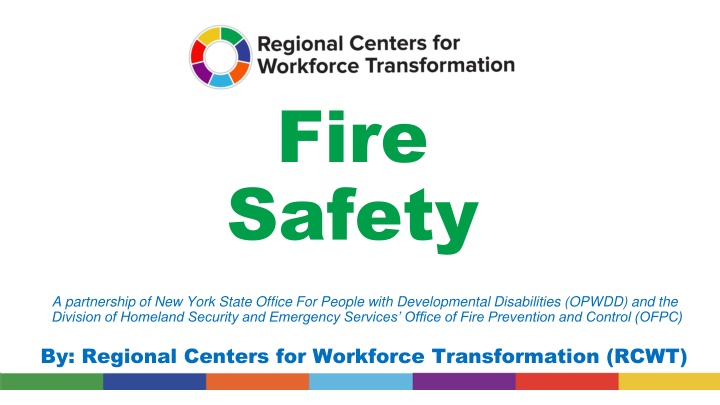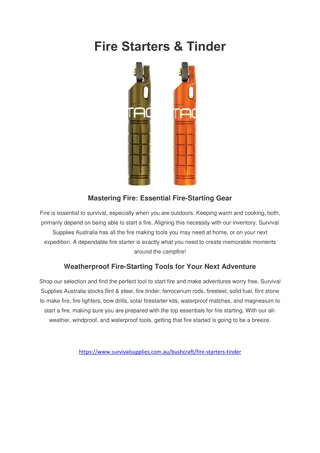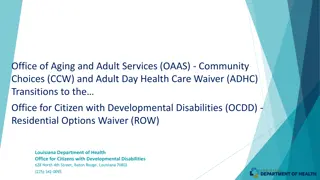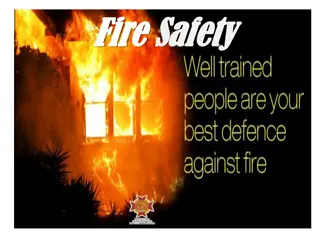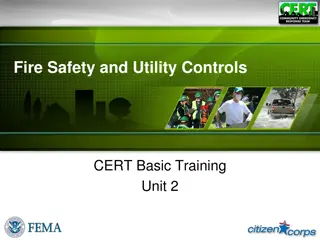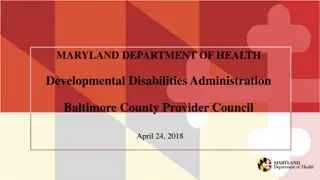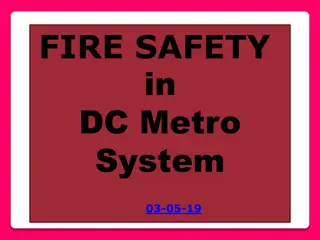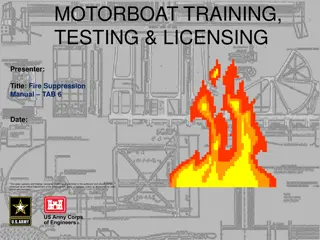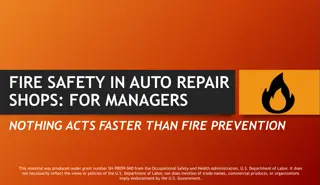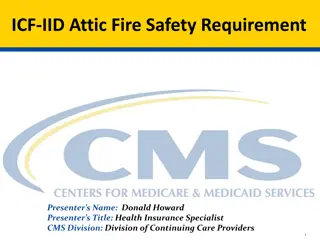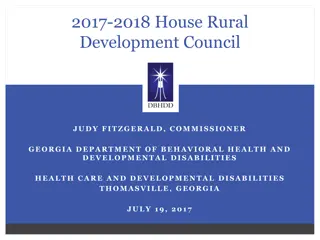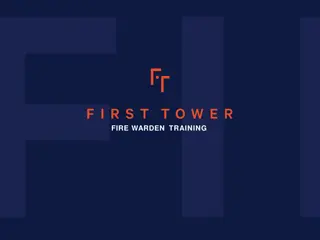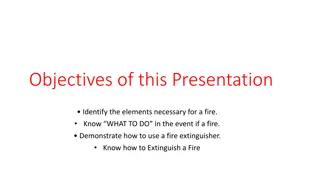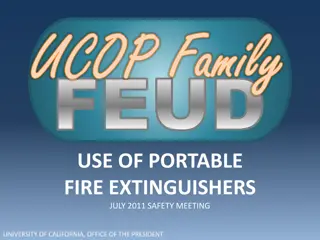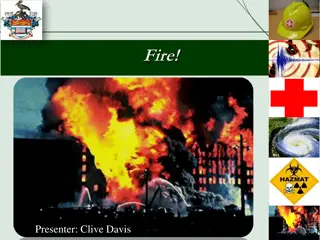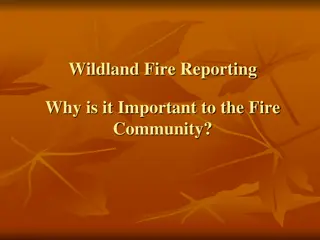Fire Safety Training for Developmental Disabilities Support Professionals
A comprehensive training partnership between the New York State Office for People with Developmental Disabilities (OPWDD) and the Division of Homeland Security and Emergency Services Office of Fire Prevention and Control (OFPC) focusing on fire safety. The course covers understanding the effects of fire, the science of fire, causes and risks in a home setting, staff roles in fire safety, and proper fire safety procedures. Learners will explore DSP Core Competencies and the NADSP's Code of Ethics to enhance their professionalism and safety support skills.
Download Presentation

Please find below an Image/Link to download the presentation.
The content on the website is provided AS IS for your information and personal use only. It may not be sold, licensed, or shared on other websites without obtaining consent from the author.If you encounter any issues during the download, it is possible that the publisher has removed the file from their server.
You are allowed to download the files provided on this website for personal or commercial use, subject to the condition that they are used lawfully. All files are the property of their respective owners.
The content on the website is provided AS IS for your information and personal use only. It may not be sold, licensed, or shared on other websites without obtaining consent from the author.
E N D
Presentation Transcript
Fire Safety A partnership of New York State Office For People with Developmental Disabilities (OPWDD) and the Division of Homeland Security and Emergency Services Office of Fire Prevention and Control (OFPC) By: Regional Centers for Workforce Transformation (RCWT)
Materials Needed & Expectations Materials Needed & Expectations Please bring with you an open mind and willingness to learn! The recommendation is that all activity pages and assessments go to a designated person within the organization (i.e. training dept. or Frontline Supervisor) to help with tracking & development strategies related to Direct Support Professional (DSP) Core Competency training, and evaluations A pen or pencil and a few sheets of paper for learner notes. You can also take notes on your computer as you go, if you prefer that There are two assessments (1 pre and post), three quizzes, and three learner activities built within the training For more information about Direct Support Core Competencies and the DSP Code of Ethics, please visit workforcetransformation.org Please print the learner activities before beginning. There is one activity for each video
Learner Objectives 1. Understand the effects of fire on the services provided and the people we support 2. Learn about the science of fire and how it spreads 3. Learn the causes and risks of fire in a home setting 4. Understand staff s role in fire prevention, safety and fire drills 5. Review proper fire safety procedures including RACE
OPWDDs DSP Core Competencies OPWDDs DSP Core Competencies and the NADSP s Code of Ethics and the NADSP s Code of Ethics As a standard practice, you will see references, and connections to the OPWDD DSP Core Competencies and NADSP s Code of Ethics throughout each training module offered by RCWT The Core Competencies represent the day-to-day valuable work that DSPs perform when serving individuals with Intellectual and Developmental Disabilities (I/DD) and they are the foundation of our work supporting people
Which DSP Core Competencies Are in this Course? Which DSP Core Competencies Are in this Course? Goal Area 3: Demonstrating Professionalism I: Exhibiting Professional Behavior K: Creating Meaningful Documentation Records Goal area 4: Supporting Safety P: Supporting Health and Wellness Goal area 5: Supporting Safety S: Supporting Safety T: Ensuring Safety During Environmental Emergencies
Pre Pre- -Assessment Assessment Please take a moment and complete this pre-assessment This assessment is meant to gage your knowledge base before the training begins and then again at the end. Assessments also help the training developers to ensure the training has the necessary information Scores will not affect your ability to successfully complete the training
Pre Pre- -Assessment Assessment
Fire Safety Fire Safety As a DSP, your role in fire safety starts with training and continues through fire drills to providing support during a fire evacuation It s a vital part of the job and something to be aware of every day and every night Fire prevention is the key ingredient in Fire Safety The repeated practice of RACE is integral to effective fire safety training for you and for the people you support RACE is an acronym used to help us remember how to respond if there is a fire - Rescue / Alarm / Contain / Evacuate
R.A.C.E. R.A.C.E.
Fire Drills Fire Drills Each fire drill should be run under the most realistic conditions This includes blocking exits during drills and running fire drills during all times of day and night and in all weather conditions Often, people act differently during a fire drill during the day than at night, so it is crucial you document how each person you support responds to the fire drill Keep building people s skills when it comes to fire drills and evacuating the building as quickly as possible. We will circle back to RACE and fire drills at the end of this course Now we are going to take a deeper dive into Fire Safety by watching 3 modules by OPWDD
A Quick Note Before We Start Please have each video s worksheet ready and follow along during the training videos The videos used in this training have great information about fire safety and were developed with OPWDD and the Division of Homeland Security and Emergency Services Office of Fire Prevention and Control (OFPC) However, you will notice that language in the videos is not person first. For example, they use the term consumer many times. Because the videos are so informative, we have decided to use them until new ones are released by OPWDD We appreciate your understanding about the use of language in these videos and hope that the information is informative. We apologize for the language that is not person centered.
I. Effects of Fire on the Services Provided and the People We Support
OPWDD Fire Safety Video: Module 1 1. Watch Video 1. Fill out the activity as you watch and learn or at the end https://www.youtube.com/watch?v=F95RHUgq-hA
II. Science of Fire & How it Spreads Causes and Risks of Fire in a Home Setting
OPWDD Fire Safety Video: Module 2 1. Watch Video 1. Fill out the activity as you watch and learn or at the end https://www.youtube.com/watch?v=3-9j4U-szAU
III. Staff s Role in Fire Prevention and Safety
OPWDD Fire Safety Video: Module 3 1. Watch Video 1. Fill out the activity as you watch and learn or at the end https://www.youtube.com/watch?v=frGNq088SlY
IV. Proper Fire Safety Procedures & Prevention
Fire Prevention Fire Prevention Fire prevention is the key ingredient in Fire Safety Common Fire Starters: Not cleaning the lint out of the dryer Cooking accidents Candles Smoking Overloading the outlets Putting things on or near a lamp Please be aware of these common fire starters and do your part to prevent fires due to these causes when supporting people. Prevention is key!
A Little More on A Little More on R R.A.C.E. .A.C.E. Rescue: The SECOND you detect a fire, begin to rescue everyone in the building This means you assist the people you support and your co-workers in evacuating as quickly as possible. This why we do so many fire drills! Remember to stay calm. The more panicked we are, the harder it is to make quick, correct decisions - especially if smoke is in the air and your oxygen is depleted and visibility has been compromised. Stay calm, and low to the ground. Covering your mouth helps to lessen the amount of smoke you may be inhaling Time is of the ESSENCE! You have only seconds to safely evacuate!
R. R.A A.C.E .C.E Alarm: Use the fire pull box if that what is available in the location When calling 911 or the local fire department, do so only from a safe location Some locations have alarms that are wired to the local fire department and alert fire and rescue that the alarm has been activated Do not rely on those alarms as the only way to get the fire department to the site - call 911 or the local number as well
R.A. R.A.C C.E. .E. Confine: After everyone has left the space, close doors to area where the fire is located Do NOT lock doors - this allows firefighters to search areas quickly Do NOT stop to get personal belongings such as cell phones, purses etc.
R.A.C. R.A.C.E E. . Evacuate: Exit through the nearest, safest door (or window) to your fire evacuation meeting spot practiced during your fire drills If opening a door to a hallway, check that the exit is safe Touch the top of the door with the back of your non-dominant hand If the door is cool, touch the bottom of the door with your non-dominant hand If the door is cool, check the doorknob to ensure it is cool If everywhere you touch is cool, open door carefully to evacuate the area Ensure everyone is at the fire evacuation meeting location. Count and count again. Communicate with Fire Company professionals if you think someone is in the building and could not rescued Do NOT re-enter the building with the fire until authorized by the Fire Professionals and it s safe to do so!
R.A.C. R.A.C.E E. . More on Evacuating: Everyone should have a fire safety plan that clearly identifies your primary, secondary and tertiary plan of evacuation Ask your supervisor where to see that fire evacuation plan if you don t already know what those exits Fire extinguishers are used for evacuating! DSPs should NOT be fighting fires . Fire Extinguishers are there to help with a safe exit and lessen any life-threatening emergencies
More on Fire Drills More on Fire Drills Fire drills are an essential part of any staff s work and a key ingredient in the fire safety plan One challenge for DSPs is that the fire drill goes off and their first reaction is to immediately tell the people they support to follow the fire evacuation plan This does not allow the people we support to practice the most independent level of evacuation possible for them Each person you support has their own fire evacuation plan which will be reviewed with you when you start working at a program During a fire drill KEEP TO THE PLAN and document any changes or refusals This might mean watching the person you support for a moment when the alarms go off to see if they respond to the alarm and follow their plan Your role in a fire drill is to support the people receiving services and document the drill accurately and promptly
After a Fire Evacuation After a Fire Evacuation Ensure you and the people you support are aware of the fire evacuation meeting spot location This location should be away from: The program/location of the fire The entrances and exits The parking or path for fire fighters to enter the building Fire hydrants or standpipes Once at the meeting site, this might be the first safe time to call 911 or the local fire department number
Human Behavior and Fire Human Behavior and Fire Resistance to task interruption: People often delay evacuation to finish tasks, make or complete phone calls, etc. Search for social confirmation: Especially in situations where the nature or severity of the risk is unclear, people tend to discuss the situation and to then make group decisions Lack of confirming information: People are less likely to respond to an alarm when they re unable to detect smoke, flames, or other sensory cues Personal physical barriers: Things like poor physical condition, uncomfortable footwear, and even bad weather can cause people to delay evacuation in the hope that it will turn out to be a false alarm Environmental barriers: Environmental barriers that can delay evacuation include lack of training, lack of knowledge of the building, a history of false alarms, or a company culture where people fear they ll be penalized for evacuating unnecessarily These are factors that make surviving a fire more difficult!
Human Behavior and Fire Human Behavior and Fire All of us run the risk of responded poorly to a fire. However, the people we support are even more vulnerable and at risk with fire prevention and evacuating properly Why is that? Often people with ID/DD have processing delays which may affect their abilities to respond quickly to a fire. Also they may do things (or not do things) that puts them at higher risk Sometimes the people we support have additional challenges worth noting: Some may struggle with any change of routine and / or the addition of sensory input. For example, you may support someone with Autism, and they may have a sensitivity to loud sounds, smells and or large groups of people. These factors can sometimes lead to challenging behaviors which now requires more skill and proactive support needed to keep people safe You may support someone with a physical disability that may make it more difficult to move quickly Note, these are real challenges that should be discussed during fire drills and documented
Example of a Good Fire Evacuation Plan Example of a Good Fire Evacuation Plan
Remember! If you are Remember! If you are competent knowledge knowledge learned today, you will be demonstrating learned today, you will be demonstrating skills in Goal areas 3, 4 and 5! skills in Goal areas 3, 4 and 5! competent and can apply your and can apply your
On the Job Training Guide On the Job Training Guide The role of staff in OPWDD-funded programs is to be a first responder. You are responsible for the safety of the people you support and the training you receive will allow you to provide that safe and supportive environment When you begin working at a program, it is encouraged that you review the below information with your on-site supervisor. This can be also be used in combination with anything else your organization or supervisor requires for your professional development Click on the link below to access the On the Job Training Guide for this training module
NY States DSP Core Competencies NY State s DSP Core Competencies and the NADSP Code of Ethics and the NADSP Code of Ethics Remember to keep the DSP Core Competencies and the NADSP Code of Ethics in your tool belt all the time!
Goal 1: Putting People First Goal 2: Building and Maintaining Positive Relationships Goal 3: Demonstrating Professionalism Goal 4: Supporting Good Health Goal 5: Supporting Safety Goal 6: Having a Home Goal 7: Being Active and Productive in Society
Post Post- -Assessment Assessment Please take a moment and complete this post- assessment This assessment is meant to gage your knowledge base before the training begins and then again at the end. Assessments also help the training developers to ensure the training has the necessary information Scores will not effect your ability to successfully complete the training
Post Post- -Assessment Assessment
Find us Online Facebook Instagram YouTube
Thank You For All That You Do!
References All images in this presentation have been published under a Creative Commons Zero (CC0) license. Please click on each picture to review the creator attributions, when available, associated with each picture. https://www.youtube.com/watch?v=F95RHUgq-hA Bing will now filter through and find creative commons images under the following categories; Public Domain , Free to Share and Use , Free to Share and Use Commercially , Free to Modify, Share, and Use , and Free to Modify, Share, and Use Commercially . https://www.pexels.com/photo/photograph-of-a-burning-fire- 672636/ https://www.youtube.com/watch?v=frGNq088SlY ABOUT CREATIVE COMMONS CC Search is a tool that allows openly licensed and public domain works to be discovered and used by everyone. Creative Commons, the nonprofit behind CC Search, is the maker of the CC licenses, used over 1.4 billion times to help creators share knowledge and creativity online. https://www.youtube.com/watch?v=F95RHUgq-hA https://smokeguard.com/blog/2019/january/01/designin g-for-human-behavior-fire-safety-considerations
